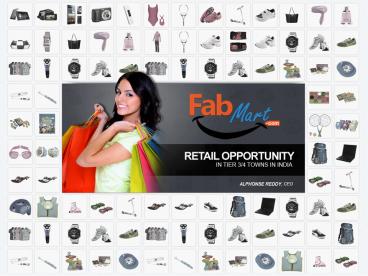FabMart
Title:
FabMart
Description:
FabMart is the pioneer in retail for tier 3 and 4 cities in India. – PowerPoint PPT presentation
Number of Views:116
Title: FabMart
1
(No Transcript)
2
GROWTH IN CONSUMER CONSUMPTION
Consumption will grow 4x over 2005 2025. Urban
India will account for more than two-thirds of
this growth as urban household income will grow
3.3x over the same period.
Aggregate annual consumption (Bln, Indian rupees,
2000)
Source MGI India Consumer Demand Model, v1.0
3
GROWTH IN CONSUMER CONSUMPTION
Consumption will grow 4x over 2005 2025. Urban
India will account for more than two-thirds of
this growth as urban household income will grow
3.3x over the same period.
Aggregate consumption per Urban Household (Indian
rupees, 2000)
6.1
2.9
Source MGI India Consumer Demand Model, v1.0
4
URBAN CLASSIFICATION AND FOCUS OF ORGANIZED RETAIL
Urban areas are classified into four types
depending on population. Traditionally, organized
retail chains focus on tier 1, 2 and tier 3
(limited). There is a clear gap when it comes to
Tier 4 cities.
Bangalore Hyderabad, Mumbai Kolkata DelhiChenna
iAhmadabadPune
Surat Kanpur Nagpur Lucknow Jaipur Kochi Vadodara
Indore
Tiruchirapalli Amritsar Faridabad Aurangabad Allah
abad Gwalior JodhpurRaipur Bhubaneswar
RohtakRurkelaUdaipur AnandFaizabadHassan Shiml
aRoorkeeShillong
Ludhiana Madurai Bhopal Patna Nasik,
Agra Varanasi Rajkot
Tier 1Major cities
Tier 2Mainstream cities
Tier 3Climbers
Tier 4Large towns
8 cities Population gt 4 million
26 cities Population gt 1 million
33 cities Population gt 500,000
33 cities 5,094 towns
Population for each city estimated using the
average urban household size Source The Great
Indian Middle Class, NCAER MGI India Consumer
Demand Model (v1.0) MGI analysis
5
POTENTIAL IN TIER 4 CITIES
40 of total disposable income is generated in
Tier 4 cities
Total Households (million, (share))
Average income per household (1000, Indian Rupees)
Total disposable income (Bin, Indian Rupees
(share))
Note Disposable Income estimated using income
distribution of households from NCAER and model
estimates of average household income Figures
are rounded to the nearest integer and may not
add up to 100 Source The Great Indian Middle
Class, NCAER MGI India Consumer Demand Model,
v1.0 MGI analysis
6
SUMMARY OF OPPORTUNITY
This leaves a huge unmet demand in serving the
needs of affluent customers in smaller towns.
- Existing mom-and-pop stores are not able to
meet the demands of affluent customers in towns. - Organized retail chains are yet to penetrate
these towns. - Ecommerce is not yet a viable channel given that
customers are not tech savvy, psychological
barriers and limited infrastructure.
7
FABMART TARGET SEGMENT
The key focus of FabMart by MRPL is to address
the needs of affluent customers in Tier 3 and 4
cities.
FabMart by MRPL by MRPL Organized retail
Focus of FabMart by MRPL
Key success factors to serve affluent customers
in towns
1
- Product availability A wide range of products
and services should be available. - Convenience The process of shopping should be
convenient and fun. - Confidence Customer should trust the seller and
the brand. - Operational control A high quality of customer
experience needs to be ensured with a tightly
managed service delivery model. - Lean scalable model Since volumes will be low
in any given town, the model should be lean but
highly scalable.
2
3
4
5
8
COMPETITIVE ANALYSIS
E-commerce
Shopping from adjacent cities
In the target towns
Mom Pop stores
Large format retail
- The typical mom-and-pop store serving customers
in the town
- Large format retail stores that are occasionally
seen in some tier 3/4 towns
- E-commerce chains such as Flipkart, Myntra etc.
- Customers going to the nearest city to buy goods
that are not normally available
Comments
Value proposition to the customer
- Pros
- Convenience
- Trust
- Instant gratification
- Cons
- Limited variety
- May not be the best deals
- Pros
- Variety and good deals
- Cons
- Various links in the value chain (from a small
town point of view) are not yet mature i.e.
Technology, Logistics, Payments etc., - Trust deficit
- Familiarity with online shopping required
- No touch-and-feel experience
- Pros
- All the benefits of a typical LFR store
- Cons
- Involves prior planning and travel
- Returns are not possible if the city is located
at a distance
- Pros
- Convenience
- Trust
- Instant gratification
- Variety and deals
- Cons
- Is not present in most of the target towns
Comparative Threat
- Low-Medium
- Low
- Low-Medium
- High
9
ABOUT FABMART BY MRPL
FabMart by MRPL aims to simplify shopping for
customers in smaller towns in India while
offering them an unmatched online shopping
experience. We are the only company in India that
is exclusively focused on catering to customers
in small towns by bringing in a wide range of
products offered by a multitude of brands. We
want to combine our industry expertise,
technology know how to offer our customer in
towns two things Fastest and best e-commerce
experience, and Timely delivery in the
towns. The Team Alphonse Reddy Founder
CEO, 12 years industry experience spanning
sales, marketing, strategy and finance. BE
(BITS, Pilani) and MBA (INSEAD Business
School) Investors/Advisory Team Hemu Javeri
Executive Director, Forum Synergies, a
150m PE fund. Previously CEO of
Madura Garments, Nike and Home Solutions. Anand
Morzaria CEO of Pennywise Solutions.
MSc Finance (BITS,
Pilani) Ashish Agarwal Investment Director,
Navis Capital, a
3b PE fund. MBA (INSEAD Business School)
10
(No Transcript)































